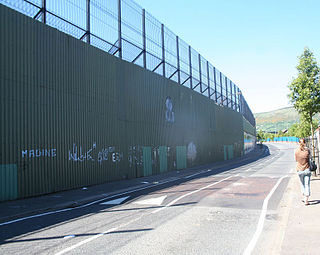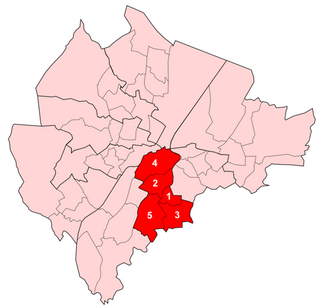Related Research Articles

Belfast is the capital city and principal port of Northern Ireland, standing on the banks of the River Lagan and connected to the open sea through Belfast Lough and the North Channel. It is the second-largest city on the island of Ireland, with an estimated population of 348,005 in 2022, and a metropolitan area population of 671,559.

Marquess of Donegall is a title in the Peerage of Ireland held by the head of the Chichester family, originally from Devon, England. Sir John Chichester sat as a Member of Parliament and was High Sheriff of Devon in 1557. One of his sons, Sir Arthur Chichester, was Lord Deputy of Ireland from 1605 to 1616. In 1613, he was raised to the Peerage of Ireland as Baron Chichester, of Belfast in County Antrim. When he died childless in 1625 the barony became extinct.

George Augustus Chichester, 2nd Marquess of Donegall KP, PC (Ire), styled Viscount Chichester until 1791 and Earl of Belfast from 1791 to 1799, was an Anglo-Irish nobleman and politician.

The Falls Road is the main road through West Belfast, Northern Ireland, running from Divis Street in Belfast City Centre to Andersonstown in the suburbs. The name has been synonymous for at least a century and a half with the Catholic community in the city. The road is usually referred to as the Falls Road, rather than as Falls Road. It is known in Irish as the Bóthar na bhFál and as the Faas Raa in Ulster-Scots.
The Laganside Corporation was a non-departmental public body formed by the Laganside Development Order 1989 with the goal of regenerating large sections of land in Belfast, Northern Ireland adjacent to the River Lagan. This development area was expanded in 1996 to include areas closer to the city centre.
Belfast City Centre is the central business district of Belfast, Northern Ireland.

Belfast Castle is a mansion located in Cave Hill Country Park in Belfast, Northern Ireland, in a prominent position 400 feet (120 m) above sea level. Its location provides unobstructed views over the City of Belfast and Belfast Lough. There have been several structures called "Belfast Castle" over the centuries, located on different sites. The current "castle" is a Victorian structure, built between 1867 and 1870 on the slopes of Cave Hill, and is Grade A listed. The main entrance into the Belfast Castle Demesne is now where Innisfayle Park meets Downview Park West, just off the Antrim Road. The original main entrance into the current demesne was formerly on the Antrim Road itself, where Strathmore Park now meets the Antrim Road.

The Donegall Road is a residential area and road traffic thoroughfare that runs from Shaftesbury Square on what was once called the "Golden Mile" to the Falls Road in west Belfast. The road is bisected by the Westlink – M1 motorway. The largest section of the road, east of the Broadway junction with the Westlink, has a community which self-identifies as predominantly Protestant while the community on the other side of the Westlink – M1 motorway self-identifies as predominantly Catholic.

Ormeau Park is the oldest municipal park in Belfast, Northern Ireland, having been officially opened to the public in 1871. It is owned and run by Belfast City Council and is one of the largest and busiest parks in the city and contains a variety of horticulture, woodland, wildlife and sporting facilities.

The buildings and structures of Belfast, Northern Ireland comprise many styles of architecture ranging from Edwardian through to state-of-the-art modern buildings like the Waterfront Hall. The city's beautiful Edwardian buildings are notable for their display of a large number of sculptures. Many of Belfast's Victorian landmarks, including the main Lanyon Building at Queens University in 1849, were designed by Sir Charles Lanyon.

Ormeau Road is a road in south Belfast, the capital of Northern Ireland. Ormeau Park is adjacent to it. It forms part of the A24.

Interface area is the name given in Northern Ireland to areas where segregated nationalist and unionist residential areas meet. They have been defined as "the intersection of segregated and polarised working class residential zones, in areas with a strong link between territory and ethno-political identity".
James Dawson Stelfox is an architect from Belfast, Northern Ireland. He is the former chairman of Consarc Design Group and in May 2008, he was elected president of the Royal Society of Ulster Architects.
The Tribeca Belfast development, formerly known as North East Quarter and previously Royal Exchange, is a planned £500 million development based in the north east of Belfast City Centre. It is a major mixed-use regeneration scheme, with a total area of 1.5 million sq ft (0.14 million m2) as of 2018. The development has generated controversy since its inception in 2003. Over the years, opposition has been levelled against its lack of care towards existing important built heritage, lack of integration with local small businesses and arts organisations and even its brand name, and much of its existence so far has been in the context of an arson attack on one of the existing buildings in 2004, while under the ownership of the developers.

The Linen Quarter is an area of Belfast, Northern Ireland. The name is derived from the great many linen warehouses that are still present in the area. The Linen Quarter is host to some of the major cultural venues of Belfast, including the Ulster Hall and Grand Opera House, alongside a large number of hotels, bars, restaurants and cafes. The district also includes the main transport hub of Belfast.

Laganbank was one of the nine district electoral areas in Belfast, Northern Ireland which existed from 1985 to 2014. Located in the south of the city, the district elected five members to Belfast City Council and contained the wards of Ballynafeigh, Botanic, Shaftesbury, Stranmillis, and Rosetta. Laganbank, along with neighbouring Balmoral, formed the greater part of the Belfast South constituencies for the Northern Ireland Assembly and UK Parliament.

The Donegall Street bombing took place in Belfast, Northern Ireland on 20 March 1972 when, just before noon, the Provisional IRA detonated a car bomb in Lower Donegall Street in the city centre when the street was crowded with shoppers, office workers, and many schoolchildren.

St. Patrick's Church, Belfast is a Catholic church, built in the Romanesque Revival style with a four-stage tower and spire rising from the front west elevation. It is located in Donegall Street area of Belfast, Northern Ireland. The first church opened on the site in 1815 while the current building opened in 1877.
Robert McKinstryOBE, ARIBA was a Northern Irish architect who specialised in conservation and restoration work. McKinstry worked on many prestigious projects including the restoration of St Anne's Cathedral, the Crown Liquor Saloon, the Arts Council of Northern Ireland Gallery, and the Grand Opera House, Belfast.
References
- ↑ "Belfast Buildings Trust, Northern Ireland charity no. 100818". Charity Commission for Northern Ireland.
- ↑ "Trustees | Prince's Regeneration Trust". Archived from the original on 28 July 2013. Retrieved 4 March 2013.
- ↑ The Prince of Wales – HRH arrives in Northern Ireland and opens a first phase of a new hospital in Belfast
- ↑ "Case Studies". Archived from the original on 24 August 2007. Retrieved 10 April 2008.
- ↑ "Christ Church". Archived from the original on 25 July 2008. Retrieved 10 April 2008.